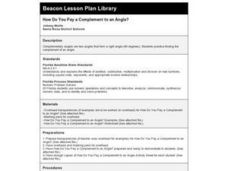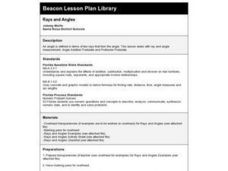Curated OER
"Math Curse" by Jon Scieszka and Lane Smith
Students use percents to solve problems, see math in the real world, and make reasonable choices pertaining to percents.
Curated OER
Geometry in Nature
Students examine how the circumference, diameter, and the relationship of Pi of a circle are related. They count the summer rings of a tree to determine its growth.
Beacon Learning Center
Angles and Algebra
Young scholars calculate angle measure for triangles and complementary/supplementary angles. After a lecture/demo, students utilize a worksheet imbedded in this plan to gain practice.
Curated OER
Determining Angle Measure with Parallel Lines
Students observe and solve examples of corresponding angle postulates, alternate interior angle theorems, and exterior and consecutive angles. They complete the Determining Angle Measure With Parallel Lines worksheet.
Curated OER
Doing Battle With Radical Equations
Learners observe and solve examples of equations involving radicals. They complete a Doing Battle With Radical Equations worksheet and checklist.
Curated OER
Going My Way (High School Math)
High schoolers solve uniform motion problems using formula d = rt.
Curated OER
How Do You Pay a Complement to an Angle?
Students observe and solve examples of the complementary angle theorem. They complete the How Do You Pay a Complement to an Angle worksheet, and write a response in their math journal.
Curated OER
Is Your Square Complete?
Young scholars practice solving quadratic equations using a form called Complete the Square.
Curated OER
Rays and Angles
Students view examples of a ray, opposite rays, collinear rays, angles, and straight angles. They discuss and demonstrate how to use a protractor and complete worksheet problems on rays and angles.
Curated OER
Sloping and Intersecting a Linear Function
Students examine and discuss typical linear equations, and the difference between a linear and nonlinear equation. They observe examples of linear equations and complete a worksheet.
Curated OER
Testing For Congruent Triangles
Students define and discuss congruency and the corresponding parts between congruent triangles. They create a pair of congruent triangles, test for congruency, and complete a worksheet.
Curated OER
The Case of the Missing Middle Term
High schoolers examine the difference of squares equation, and multiply binomials using the FOIL method. They complete the Case of the Missing Middle Term worksheet.
Curated OER
The Mystery of the Accelerating Race Car
Students define and discuss acceleration and how to compute acceleration. They observe examples of computing acceleration, and complete a worksheet using the correct formula.
Curated OER
Who Won the Cross-Country Meet?
Students write verbal expressions into algebraic expressions and solve the expressions. They determine who wins a race by determining the algebraic expression.
Curated OER
Making Good Investments
Young scholars compare different aspects of investing money from traditional savings accounts to money market accounts. They research investment accounts at local banks and compare them.
Curated OER
Patterns in Pascal's Triangle
Young scholars examine the patterns that exist in Pascal's Triangle. They explore multiples and factors. Sudents use an applet to create and color the multiples in Pascal's Triangle.
Curated OER
Finding Patterns in Fractals
Students discover patterns and sequences. They use a website to explore patterns and fractals. Students share their discovery of fractals and their patterns with the class. They develop a list of patterns used in everyday life.
Curated OER
Introduction to Arithmetic and Geometric Sequences
Pupils examine the concept of sequences. Students create a sequence using varied starting numbers, multipliers, and add on values. Pupils practice determining the starting values to use in order to produce a desired sequence.
Curated OER
Buying a Car
Students complete the PLATO ¿¿ Educational Software lesson: Math Problem Solving: Car Costs to determine if he/she can afford to drive the car they are planning to buy.
Curated OER
The Part-Adder 2
Third graders use mental-math strategies to solve two-digit plus two-digit addition problems. They observe and discuss online demonstrations, solve word problems as a class, and independently solve problems and describe their solutions...
Curated OER
The Multiplier (small 2-digit by 1-digit numbers)
Second graders study digits in 2- or 3-digit whole numbers. They write and solve story problems which involve whole numbers, using addition, subtraction, multiplication, or division.
Curated OER
The Divider (whole number remainders)
Third graders use the instructional activity to support division of whole numbers where there is either no remainder or whole number remainders. They are able to
slit division problems into parts using known multiplication and division...
Curated OER
Perplexing Perimeters
In the process of constructing their own "rulers" Students develop a sense of the size of a centimeter and meter. Students select the appropriate "ruler" for the tasks. Finally, 3rd graders calculate the perimeter of objects using...
Curated OER
Slosh, Dribble, and Plop
Students recognize the need for a standard unit of volume. They estimate and measure to the nearest liter. Also they relate the liter to the familiar everyday containers.
Other popular searches
- Fractions to Decimals
- Fractions Decimals Percents
- Percent Fractions Decimals
- Fractions to Decimals Games
- Fractions Decimals List
- Ordering Fractions Decimals
- Change Fractions to Decimals
- Decimals and Fractions
- Relating Fractions Decimals
- Fractions Decimals Percents
- Fractions Decimals Inquiry
- Convert Fractions to Decimals

























